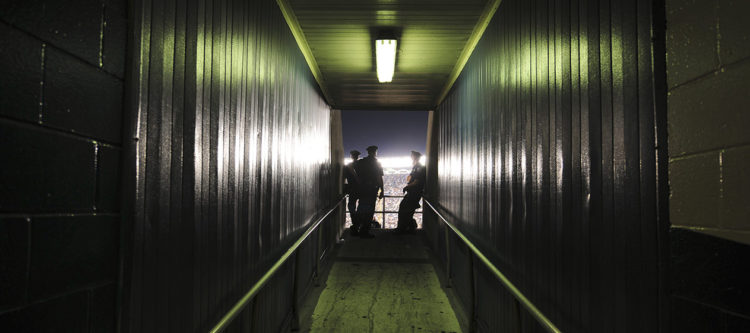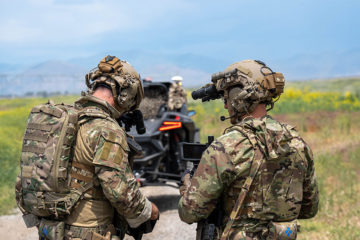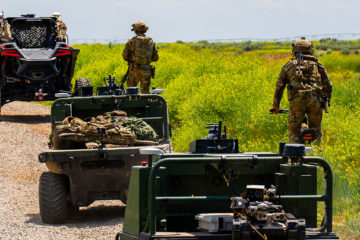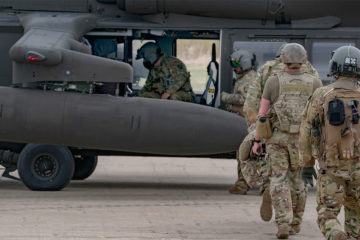3 ways mobile mesh networking can keep sports fans safe

Super Bowl Sunday is a day that resonates with many Americans, especially when they attend in person. People love the rush of watching a touchdown, the smell of fresh hot dogs, and the energy from the crowd. Fans also enjoy using their cell phones to make social media updates and stay connected to friends and loved ones.
But that increased traffic on cellular networks can come with consequences. As USA Today explained in an article from a few years ago,
…when large groups of people collect in one area…they have to share limited bandwidth. If too many people try to log onto a mobile network at once, it can become overloaded. While many venues and stadiums deploy Wi-Fi and cellular service boosters or portable antennas ahead of big events, there’s still a chance connectivity may be affected by thousands of people eagerly snapping, streaming, and selfie-ing to their heart’s content.
In a previous article, we discussed how stadium networks can often become overloaded and how that impacts the safety of fans as well as event security teams. In order to keep fans safe during large events like the Superbowl, communication is key. Security teams and police need efficient communication and coordination for effective operations.
Situations can escalate rapidly when you have large crowds. With a congested communications infrastructure, there is no way for security personnel and law enforcement to coordinate efforts and communicate when or where they need assistance. To enable communication and coordination between all parties involved in stadium security, private event security personnel, law enforcement professionals, and emergency responders need a more reliable form of communication than cell phones or radios.
Is [a] UAS the property of a badly misguided drone-loving hobbyist looking to get unique images from the big game? Or is it a malicious device being piloted by someone that wants to cause harm to the people in the stadium? There is no way for law enforcement and stadium security professionals to know.
Mobile mesh networking offers an easy-to-deploy, interoperable solution that can ensure all parties can communicate even when traditional, terrestrial communications networks fail. Here are three ways mobile mesh networking devices – such as the goTenna Pro X – are the ideal solution for keeping people safe during large events like the Superbowl:
Fostering comms in crowded places
During the Super Bowl at SoFi stadium in Los Angeles, as many as 57,618 devices in the 70,048-strong crowd were connected at any one time. Over the course of the game, 31.2TB of data was transmitted via the network – an 18 percent increase from Super Bowl LIV in 2020 and five times the season average. Fans enjoy using their cell phones during the Super Bowl. I can’t blame them. For many people, attending the Super Bowl is a once-in-a-lifetime opportunity.
Not only does having so many people cause major strain on cell phone towers, but it also makes voice communications rather difficult. Security teams have to contend with many voices, loudspeakers, and even moving equipment. Due to this, it is easy to miss a call on the radio.
With mobile mesh networking, security personnel can send text messages on a secure and reliable communication network. There is no concern that voice communication was misheard or missed, and the text communication remains on the user’s mobile device, where they can see it in the future, if necessary.
Delivery connectivity deep underground
Many stadiums have tunnels and underground areas – this is where cell phone networks and radio frequencies (RF) tend to fail. If there is hardened construction, such as concrete or steel reinforcement, in the tunnels or throughout the stadium, security teams will have to contend with RF absorption, reflection and refraction to operate. This can cause intermodulation and lost messaging.
Mobile mesh networks excel in these types of environments. Because rather than being reliant on penetration or reflection, every goTenna Pro X collects and rebroadcasts any of the information that needs to be delivered.
During large events like the Super Bowl, it is imperative that all event personnel have an end-user device (EUD) connected to the mobile mesh network so they can stay in constant communication, no matter where they go. The more devices there are, the larger the network becomes.
goTenna has conducted significant testing in subterranean environments and locations, including subways and tunnel systems. The company has found that the small wavelength leveraged by mobile mesh networking devices is inherently better at penetrating underground. Also, the ability to create ad-hoc relay networks can essentially extend connectivity miles underground.
Enabling Counter UAS with mobile mesh
Another potential threat that could occur during large events, such as the Super Bowl, is the appearance of an unmanned aircraft system (UAS). The fear with UAS’s is that they are unpredictable, and their reasoning or justification for being in the area is often unknown.
Is the UAS the property of a badly misguided drone-loving hobbyist looking to get unique images from the big game? Or is it a malicious device being piloted by someone that wants to cause harm to the people in the stadium? There is no way for law enforcement and stadium security professionals to know.
This threat is a great example of a situation that escalates response requirements significantly without warning. Enhanced and clear communication as well as coordination would be a requirement to have an effective response against the UAS threat. But the ability to deny access to the drone and bring it back to Earth safely is also essential.
In the case that this occurs, the goTenna Pro X can be partnered with solutions, such as Syzygy’s Sensor Network Access Point (SNAP) and D-Fend’s EnforceAir solution. By integrating with these solutions, goTenna Pro X can enable counter UAS systems to quickly identify and disable potentially dangerous drones and keep all response personnel informed throughout the process.
How to make it happen…
Now that we have established how mobile mesh networking can help build a reliable and secure communication network, let’s talk about implementation. How should law enforcement and stadium security professionals prepare the area and their personnel to maximize their use of mobile mesh?
With mobile mesh networking, security personnel can send text messages on a secure and reliable communication network. There is no concern that voice communication was misheard or missed, and the text communication remains on the user’s mobile device, where they can see it in the future, if necessary.
During large events like the Super Bowl, it is imperative that all event personnel have an end-user device (EUD) connected to the mobile mesh network so they can stay in constant communication, no matter where they go. The more devices there are, the larger the network becomes.
If a security team needs to connect with emergency response services, a node can be connected to the top of the stadium or a news helicopter. This range would reach outside of the stadium as well to connect with the emergency response team.
To further extend reach and connectivity, nodes can be breadcrumbed throughout the stadium – including into underground areas – to function as relays. The emergency response team should also establish a mobile command post that includes an EUD on the mobile mesh network.
By planning in advance and distributing mobile mesh relays throughout – and above – the stadium, law enforcement, and security personnel would effectively create a bubble of connectivity that reaches every tactical operator and connects every – regardless of which organization they work for – anywhere in and around the stadium.







No Comment